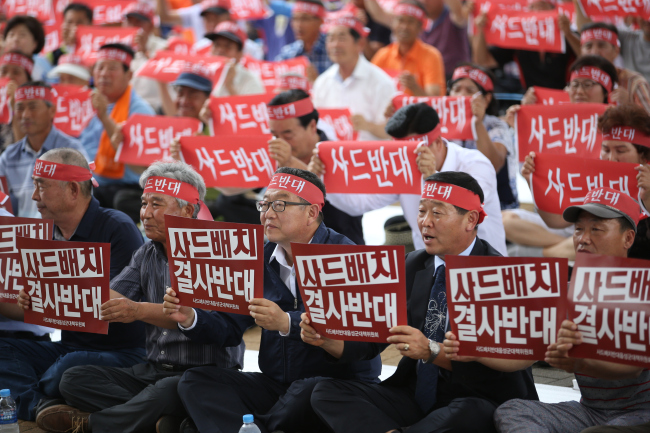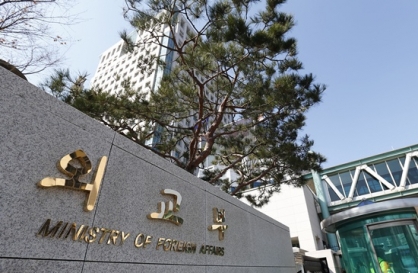[NEWS ANALYSIS] Pros and cons of potential THAAD locations
By Yoon Min-sikPublished : July 12, 2016 - 16:37
South Korea and the U.S. decided on the deployment of the Terminal High Altitude Area Defense here last week and the talk of the town has been where the advanced missile defense system will be located.
Korea and the U.S. kicked off talks to station THAAD on the peninsula in February, on the heels of North Korea’s long-range rocket launch that followed its nuclear test in January.
Various locations around the country are considered to be potential candidates including Osan and Pyeongtaek in Gyeonggi Province, Chilgok and Seongju in North Gyeongsang Province, and Yangsan in South Gyeongsang Province.
It is said that the allies are at the final stages of reaching a decision, and that they have narrowed it down to one location. Formal announcement is expected to be made within this month.
Korea and the U.S. kicked off talks to station THAAD on the peninsula in February, on the heels of North Korea’s long-range rocket launch that followed its nuclear test in January.
Various locations around the country are considered to be potential candidates including Osan and Pyeongtaek in Gyeonggi Province, Chilgok and Seongju in North Gyeongsang Province, and Yangsan in South Gyeongsang Province.
It is said that the allies are at the final stages of reaching a decision, and that they have narrowed it down to one location. Formal announcement is expected to be made within this month.

The Defense Ministry is being secretive about the spot, while those with knowledge on the matter have suggested that Yangsan or Seongju are the top candidates.
These areas have the distinct advantage of not being highly-populated. One of the main concerns from South Koreans over THAAD has been the negative effects its high-powered radar will have on the environment and health.
Minister Han Min-koo told the National Assembly Tuesday that the U.S. military has conducted an evaluation on THAAD’s effect on the environment through the system based in Guam, and said that it will not harm the health and well-being of the people.
Amid the rising controversies about THAAD, the U.S. military is set to reveal the weapon system based in Guam to the South Korean press next week.
It used to host South Korean Air Force’s air defense base, which makes it easier to set up a base for THAAD. Some observers pointed out that a Yangsan-based THAAD radar would not be able to reach China, which has been one of Beijing’s biggest concerns.
THAAD being located away from the inter-Korea border also frees it from the risk of being struck by the North’s long-range multiple rocket launchers, presumed to have a maximum range of 200 kilometers.
Deploying THAAD in the southern region -- which could potentially mean Chilgok and Gunsan in North Jeolla Province -- would mean THAAD would not be able to defend the capital region. Some 10 million people reside in Seoul. The priority of the U.S. Forces has been the protection of USFK bases stationed here.
The military is expected to use PAC-3 surface-to-air missiles to defend the region in such a case. According to the ministry’s 2017-2021 plans, the military is set to acquire and deploy the new patriot missiles by 2018.
It said this would mean that the region would be vulnerable to Pyongyang’s ballistic missiles before then. It is also close to the Gori nuclear reactor, which Yangsan Mayor Na Dong-yeon argued will threaten the lives of the city’s entire population.
Gunsan would face the double whammy of its missiles being too far to protect Seoul and its radar being too close to China. But its advantage would be the patriot missile base operated by the USFK based there, which will be effective in strengthening the air defense.
North Chungcheong Province is located in an ideal place to protect the Gyeonggi and Seoul area along with the adjacent Gyeryong military headquarters. Observers are pointing to the difficulty in acquiring an additional land and newly stationing the USFK soldiers there as hindrance for the THAAD deployment.
Close to the inter-Korea borders are Pyeongtaek, Osan and Wonju, Gangwon Province. In addition to them all falling under the range of North Korean artillery, Pyongtaek has the disadvantage of being close to a populated area.
Apart from where THAAD ends up, the fierce objection by the people will prove to be an obstacle for local authorities.
Citizens based in the aforementioned areas have insisted via press conferences and statements to resist stationing THAAD near their homes.
Gyeonggi Governor Nam Kyung-pil said he would welcome stationing THAAD in the province. On Tuesday morning, Pyongtaek-based civic groups released an emergency statement urging Nam to withdraw what he said.
Professor Kim Dong-yup of the Institute for Far Eastern Studies also raised concern that stationing a U.S. weapon system against objections from China and Russia may place the Korean Peninsula at the center of an international confrontation.
China and Russia have raised concerns that it might impede their strategic interest, but Defense Minister Han urged Tuesday not to overestimate the impact of what he called “deploying a single artillery base.
By Yoon Min-sik
These areas have the distinct advantage of not being highly-populated. One of the main concerns from South Koreans over THAAD has been the negative effects its high-powered radar will have on the environment and health.
Minister Han Min-koo told the National Assembly Tuesday that the U.S. military has conducted an evaluation on THAAD’s effect on the environment through the system based in Guam, and said that it will not harm the health and well-being of the people.
Amid the rising controversies about THAAD, the U.S. military is set to reveal the weapon system based in Guam to the South Korean press next week.
It used to host South Korean Air Force’s air defense base, which makes it easier to set up a base for THAAD. Some observers pointed out that a Yangsan-based THAAD radar would not be able to reach China, which has been one of Beijing’s biggest concerns.
THAAD being located away from the inter-Korea border also frees it from the risk of being struck by the North’s long-range multiple rocket launchers, presumed to have a maximum range of 200 kilometers.
Deploying THAAD in the southern region -- which could potentially mean Chilgok and Gunsan in North Jeolla Province -- would mean THAAD would not be able to defend the capital region. Some 10 million people reside in Seoul. The priority of the U.S. Forces has been the protection of USFK bases stationed here.
The military is expected to use PAC-3 surface-to-air missiles to defend the region in such a case. According to the ministry’s 2017-2021 plans, the military is set to acquire and deploy the new patriot missiles by 2018.
It said this would mean that the region would be vulnerable to Pyongyang’s ballistic missiles before then. It is also close to the Gori nuclear reactor, which Yangsan Mayor Na Dong-yeon argued will threaten the lives of the city’s entire population.
Gunsan would face the double whammy of its missiles being too far to protect Seoul and its radar being too close to China. But its advantage would be the patriot missile base operated by the USFK based there, which will be effective in strengthening the air defense.
North Chungcheong Province is located in an ideal place to protect the Gyeonggi and Seoul area along with the adjacent Gyeryong military headquarters. Observers are pointing to the difficulty in acquiring an additional land and newly stationing the USFK soldiers there as hindrance for the THAAD deployment.
Close to the inter-Korea borders are Pyeongtaek, Osan and Wonju, Gangwon Province. In addition to them all falling under the range of North Korean artillery, Pyongtaek has the disadvantage of being close to a populated area.
Apart from where THAAD ends up, the fierce objection by the people will prove to be an obstacle for local authorities.
Citizens based in the aforementioned areas have insisted via press conferences and statements to resist stationing THAAD near their homes.
Gyeonggi Governor Nam Kyung-pil said he would welcome stationing THAAD in the province. On Tuesday morning, Pyongtaek-based civic groups released an emergency statement urging Nam to withdraw what he said.
Professor Kim Dong-yup of the Institute for Far Eastern Studies also raised concern that stationing a U.S. weapon system against objections from China and Russia may place the Korean Peninsula at the center of an international confrontation.
China and Russia have raised concerns that it might impede their strategic interest, but Defense Minister Han urged Tuesday not to overestimate the impact of what he called “deploying a single artillery base.
By Yoon Min-sik




![[Weekender] Korean psyche untangled: Musok](http://res.heraldm.com/phpwas/restmb_idxmake.php?idx=644&simg=/content/image/2024/05/02/20240502050841_0.jpg&u=)

![[Eye Interview] 'If you live to 100, you might as well be happy,' says 88-year-old bestselling essayist](http://res.heraldm.com/phpwas/restmb_idxmake.php?idx=644&simg=/content/image/2024/05/03/20240503050674_0.jpg&u=)











![[Herald Interview] Director of 'Goodbye Earth' aimed to ask how we would face apocalypse](http://res.heraldm.com/phpwas/restmb_idxmake.php?idx=652&simg=/content/image/2024/05/03/20240503050732_0.jpg&u=)
